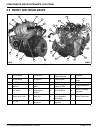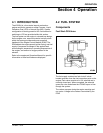
OPERATION
16 Operation TP-6901 6/14
Sensors
Heated Exhaust Gas Oxygen (HEGO) Sensor
The Heated Exhaust Gas Oxygen (HEGO) sensor
measures the amount of oxygen present in the exhaust
stream to determine whether the air–fuel ratio is too
rich or too lean.
Air Temperature / Manifold Absolute Pressure
(TMAP) Sensor
The Air Temperature / Manifold Absolute Pressure
(TMAP) sensor monitors the difference in pressure
between the intake manifold and outside (atmospheric)
pressure. This sensor also measures the temperature
of the incoming air. Data returned by the TMAP sensor
prompts the ECM to adjust the air–fuel mixture as
needed.
Knock Sensor (if equipped with turbocharger)
NOTE:
On naturally-aspirated engines, the knock sensor is not
connected to the ECM.
The Knock Sensor monitors vibrations caused by
engine knock. The ECM interprets the signals from the
Knock Sensor and adjusts the ignition timing to prevent
pre-ignition damage.
Crankshaft Position Sensor
Crankshaft Position Sensor (CPS) measures the rotary
speed and crankshaft turning angle. The ECM ensures
the ignition timing for each cylinder depending on the
turning signal. The sensor, which consists of a
permanent magnet and coil, is installed on the timing
gear cover next to the crankshaft pulley. When the
crankshaft is turning, the gear ring passes the sensor
at different speeds and causes a change of magnet
resistance at the sensor to produce a changeable
signal.
Throttle Position Sensor (TPS)
The electronic throttle control device incorporates an
internal Throttle Position Sensor (TPS), which provides
output signals to the ECM as to the location of the
throttle shaft and blade. The ECM will use the signal to
monitor and adjust the engine speed.
Engine Coolant Temperature Sensor
The engine coolant temperature sensor provides
engine coolant temperature data to the ECM. The ECM
uses this data to adjust for cold starting conditions, and
regulates various fuel and emission control functions.
Engine Oil Pressure Sender
The engine oil pressure sender ensures sufficient
lubrication throughout the engine. The sender is a
pressure valve that is monitored by the ECM. A drop in
pressure will trigger a fault code.


















